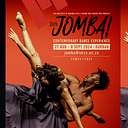Open Horizons offers us vistas and skylines beyond the stage as dancemakers reach across the screen
By Tammy Ballantyne (Guest Writer)
Viewing the ten selected long form works on JOMBA!’s re-invented fringe programme, Open Horizons, many thoughts crowded my mind — what have we gained from Covid in terms in dancemaking? What have we lost? Is this work interesting and engaging? How much more attention can I sustain watching screendance? Will young dancemakers survive the isolation of working on their own? Push and pull, push and pull, endlessly going over the uneasy questions…
And then Femi Adebajo and Ridwan Rasheed from Nigeria exploded onto the screen with their crew in Yin Yang — the power of the visual language, the use of colour and the pops of blue and orange, the pace and striking use of locations all brought together with nifty editing, a sense of humour and catchy music. The Yin and the Yang, the good and the bad, the light and the dark cleverly realised by these young choreographers who’ve had to adapt to so many difficult situations to realise their work. And how would I have seen this otherwise?
The same goes for experiencing Kenyan Maulid Owino’s surprisingly lyrical work, SONGA, in a busy street; Mzamo Kunene’s quietly, reflective solo, Conflicted, on a chair by a huge window, climbing, falling, reaching, superimposing; Nomfundo Hlongwa’s exploration of class and the layers we are forced to wear, the domestic guises women must endure played out with a striking musical score in One of Four; the collaborative Gathering of tics, gestures and manners with SA’s David Thatanelo April and Mexican Javier Valazquez Cabrero proving that it’s never too late for old dogs to learn new tricks with a quirky, conversational duo; Diana Gaya’s discordant and visually haunting solo Machozi ya Jana (Yesterday’s Tears), speaking of entrapment and loss surrounded by an unfinished apartment block in Kenya; a black and white study of the surface of the skin, like a planet rising with each breath, close-ups of skin, hair and fingers in Julia Rosenworth’s climactic e/vent Horizon; brave Mamello Makhetha’s engagement with GBV, speaking of healing and renewal against the backdrop of the Wits Great Hall and a hotel bedroom in Ore Phelele; Lewellyn Afrika’s honest and painful uncovering in OP STRAAT (THE STREETS), in a backyard with dustbins, tyres, a suitcase and dirt in his feet as props and Cebolenkosi Siphesihle Zuma, morphing deliciously from streets to a stage to a scenic rocky outcrop with poise and polish, African bow ever-present in Buchitheka Bugayiwe || Thokola Themba.
All these encounters across my screen have wrapped me in feelings of deep respect for the high quality of work in terms of film-making, editing, the use of new technologies and engagement; but can this endure? At times, there is a deep chasm looming, where artifice rears its head and clever tricks replace the essence, the stripping away. Alfred Hinkel referred to “removing the artifice, the imposed vocabularies and physical movements that inhabited our dancing bodies…towards dance in a range of vernaculars.”
Yet, we find ourselves holding onto our community across these screens: searching for new languages, new ways of deconstructing, of recognising each other and our humanity in spite of the digital (and physical) divide. Adebajo and Rasheed have me “yinning and yanging”, see-sawing to and fro, to and fro, to and fro, to and fro………….
The winners of the Long Form platform are:
1st place: Yin Yang by Femi Adebajo and Ridwan Rasheed
2nd place: Ore Phelele by Mamello Makhetha
3rd place: Machozi ya Jana (Yesterday’s Tears) by Diana Gaya
The top three works are available to view on the festival website and YouTube platforms for the remainder of the festival.
